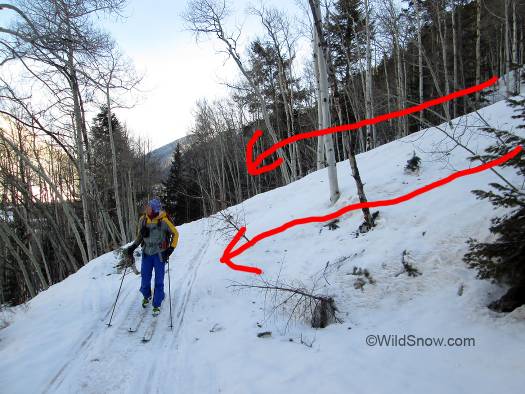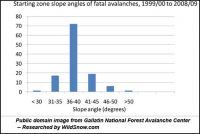
An approach trail may appear safe, but may not be. Evaluation requires study of sources such as guidebooks and maps, as well as a modicum of ability in identifying avalanche slopes that may not be entirely obvious. Lower portion of route to Opa hut, Colorado.
(We’re headed over to the Colorado Snow and Avalanche Workshop today, should be a variety of excellent blog fodder. This post seemed appropriate. Note this list is intended for newcommers to the sport. Once you gain experience, some of these concepts might exceed the norm in terms of conservative safety behavior. This post sponsored by our publishing partner Cripple Creek Backcountry. Check out their selection of just about everything for backcountry ski touring.)
1. No matter how uneducated you choose to remain, you MUST learn how to identify terrain where avalanches could occur, avalanche “slopes” and “paths.” Clues are slope angle, vegetation patterns, guidebook tips, lack of ski tracks in otherwise tracked terrain, debris from previous slides, community knowledge and more. As part of this, learn that the large spectacular avalanches are not your only threat — plenty of deaths occur in small slides. Make a game of it while you’re driving and while you’re on the approach to a zone. Most people quickly learn this skill, but it’s not in our DNA, work is required.
2. Unless you’re educated in avalanche safety protocols such as terrain recognition, only tour during days with Moderate to Low reported overall hazard levels. It’s entirely possible to ski during high hazard days provided you use low hazard terrain without threats from above — but doing so requires quite a bit of expertise. For the novice, those are usually days for the resort, perhaps both uphill and down.
3. Carry an inclinometer and use it frequently. Inclinometer content.
4. Ski where others frequently ski. General guideline for slopes at or over about 35 degrees: ten sets of tracks minimum before you hit it (for “normal” continental snow climate such as Colorado or Utah, does not apply during situations such as deep persistent slab. Don’t know what that is? Time for an avalanche safety course.)
5. Learn to measure-judge alpha angle, to avoid exposing yourself to hazards above. A number of tragic accidents have occurred when uneducated snow sliders thought they were in a safe zone, only to be taken out by a slide from above their position.
6. Avoid skiing in situations with other groups above you, and nearly always ski downhill one person at a time no matter how safe you guess the situation to be (times to gang ski: exceptionally low angled slopes during low hazard days, or springtime firm corn snow). Consider the uptrack as well, be sure to spread out if you’re in any situation with even a small amount of avalanche potential. Bluntly put: There is often nothing stupider or more unnecessary than multiple individuals being caught in the same avalanche on the uptrack. Sure, sometimes you need to bunch up, and traveling together enjoying a nice conversation are part and parcel to a nice day in the alpine — but do so with thought to more than sharing your political wisdom or relationship woes.
7. Practice a mellow, conservative attitude. When a choice is to be made, always take the more cautious version. Aristotle said “Quality is not an act, it is a habit.” Your effective safety attitude is a habit, developing habits takes time. Perhaps compare to your style of driving. Do you dart around like a NASCAR pilot when you’re in traffic? Perhaps you’ve got work to do. Is your highway style more akin to having a carpool of toddlers? You might already be mellow enough.
8. Everyone carries full avalanche safety gear: beacon; shovel ;probe. For local sojourns, beacons are switched on at home, turned off at home. Concept here is not only do beacons directly save lives, but acquiring and carrying the gear switches your mindfulness to “avalanche awareness.” (Further, you may become involved in a rescue, perhaps in terrain with more danger.) It may feel odd at first to haul full kit avy gear on super-mellow terrain. Put your pride aside and carry the gear. By the same token, don’t weigh yourself down with an embarrassing overabundance of safety gear. If your goal is mellow super-safe skiing, running around with an avalung stuck in your mouth is probably overkill. A small unobtrusive airbag backpack can be reassuring but is also likely unnecessary, that is unless you’re planning on gradually ratcheting up your goals as your skills increase. Just remember that avoiding being caught in an avalanche is your objective — trying to mitigate the consequences of a ride, with technology such as airbags, is an unequal contest.
9. Memorize the Stone Tablets of Avalanche Safety.
10. Curate your group size and companionship. Avoid individuals who tend to change the game plan in mid stride (risk escalation), and avoid large groups. Two or three people is ideal. Never split up your group.
11. Beware of placing faith in the judgment or skills of individuals who only surpass your experience level by a small amount. Likewise, beware the “expert!” who is actually not as seasoned as you’ve been led to believe. Consider hiring guides if at all in doubt of your group’s ability to handle a goal.
12. Enjoy a skiing style that involves “milking” lower pitched slopes for turns and fun. Doing so isn’t necessarily one specific style of skiing, it’s more about attitude. It’s about enjoying what you have for what you and your gear can get out of it. Ideas: Challenge your group on how precisely they can spoon tracks. Multiple laps, personal bests with daily vertical feet. Pre-planned lunch feasts at the top of the slope (bring a fondue cooker or espresso Bialetti?). Photography hero sessions. Build a kicker. Dig a few avalanche evaluation snow pits. Go for a peak summit via a safe ridge route and return the same way, perhaps leaving your skis at a lower staging area.
All you seasoned folks out there, if you got this far, critique appreciated as well as additions that could help our novice friends.
WildSnow.com publisher emeritus and founder Lou (Louis Dawson) has a 50+ years career in climbing, backcountry skiing and ski mountaineering. He was the first person in history to ski down all 54 Colorado 14,000-foot peaks, has authored numerous books about about backcountry skiing, and has skied from the summit of Denali in Alaska, North America’s highest mountain.

